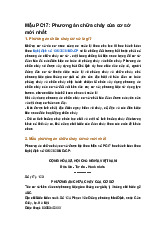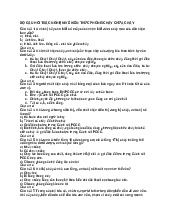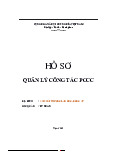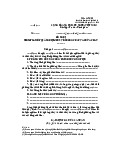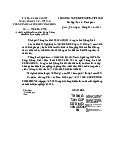





Preview text:
AEGIS™ 2.0
Conventional Fire Alarm-Suppression Control Unit Effective: March 2023 K-84-200 FEATURES •
Suppression Focused Control Unit •
Built-in Class A and Class B Circuitry •
Triple R Redundancy Provides Maximum Protection Against •
Listed for use with Kidde®, Fenwal® and Chemetron® agent
Inadvertent Release
release devices including Control Heads and Initiators •
Agency Approvals: •
Sophisticated Programmable NACs • FM Approved •
Independently Programmable Agent Releasing Circuits •
UL Listed to ANSI 864, 10th edition •
Compact Cabinet Design Supports Large Number of Input •
California State Fire Marshal
and Output Circuits •
City of New York Fire Department •
3 Detection Circuits •
Compliant with NFPA 72 •
2 Supervisory Circuits •
Licensed for entry into Kingdom of Saudi Arabia •
Option to Use SUP 1 as Fourth Detection Circuit* •
United Arab Emirates (UAE) RoHS Compliant •
1 Manual Release Circuit •
Listed for a Wide Range of Suppression Systems: •
1 Abort Input Circuit (with 6 Abort Modes) •
Kidde® ECSTM HFC-227ea and FK-5-1-12 •
3 Notification Appliance Circuits •
2 Release Circuits •
Kidde® ADSTM HFC-227ea and FK-5-1-12 •
3 Programmable and 1 Trouble Form-C Relays • Kidde® HP CO2 •
1 Auxiliary Power Output (Resettable), 1 Amp •
Kidde® IG Argonite & Nitrogen •
5.4 Amp Power Supply Unit • Kidde® FE-13TM •
120/240 V, 50/60 Hz AC Input • Fenwal® Spheres •
Easy-to-Use User Interface and Display •
Option with Door-Mounted Abort and Manual Release • Fenwal® BDCs
Switches Available •
Kidde® INDTM Dry Chemical & WHDRTM Wet Chemical •
Flexible Configuration Options Systems •
Password Protected •
Sprinkler Supervisory Service •
Digital Release Countdown •
Deluge, Pre-Action, Foam, Foam-Water Systems •
Battery Voltage and Charging Current Display •
Combination Clean Agent plus Pre-Action System •
Charging Capacity of 68 AH •
Extensive Diagnostics •
Backwards Compatible DESCRIPTION
The Kidde® AEGISTM 2.0 is a Conventional Single Hazard
Agent Releasing Unit which provides configuration
flexibility in a compact footprint to protect life and assets in
commercial, high-tech and industrial applications. The
AEGIS 2.0 control unit has a NEMA1 enclosure and an
option for door mounted Manual Release and Abort
switches to avoid the additional expense of wall mounting these items.
The AEGIS 2.0 is well equipped to handle all special
hazard extinguishing systems due to the high degree of
programming flexibility provided and the following full
complement of input and output circuits:
• Three (3) Class A or Class B Detection Circuits
• Two (2) Class A or Class B Supervisory Circuits
• Option to Use SUP 1 as Fourth Detection Circuit*
• One (1) Class A or Class B Manual Release Circuit
• One (1) Class A or Class B Abort Input Circuit
• Three (3) Class A or Class B Notification Appliance Circuits
• Two (2) Class B Agent Release Circuits
• Three (3) Programmable and 1 Trouble Form-C Relays
*Fourth Detection Circuit must contain normally open contact
closure device (not 2-wire smoke detector). DETECTION CIRCUITS
The Detection Circuits support Conventional KC2 Series
Activation of the Agent Release Circuits can either be
detectors, ESL/Interlogix 700 Series detectors, CPD-
instantaneous or delayed up to 30 seconds (maximum)
705x Ionization Smoke, PSD-715x Photoelectric Smoke
upon receipt of Manual Release input. Agent release can
and THD-705x Heat Detectors as well as Normally Open
be temporarily delayed by activating the Abort Circuit.
contact closure type devices. Two circuits are dedicated
Subsequent activation of the Manual Release overrides
to the main suppression function and can be
an Abort in process. After a Manual Release has been
programmed to activate the release circuits by either
activated, activating an Abort will have no effect. The
single-shot or cross-zone input. The user configuration
Abort input can be programmed for 5 modes of operation
allows automatic release via detection to be delayed from
or disabled entirely. These include the UL 10-second
0 to 60 seconds in 10-second intervals and also allows a
mode, the full-delay mode, the IRI mode or two NYC
choice of which of the two Agent Release Circuits to
modes. Aborts can also be programmed to be applicable activate.
for either one (ARC 1) or both Agent Release Circuits
The third Detection Circuit is programmable for either
thereby allowing use with Deluge/Pre-Action systems.
Waterflow or as an independent Detection circuit. When
NOTIFICATION APPLIANCE CIRCUITS (NAC)
programmed for Waterflow, Notification Appliance
The three Notification Appliance Circuits are rated 1.5
Circuits can be programmed as Non-Silenceable as
Amps each and accept polarized 24 VDC regulated
required by certain jurisdictions. Additionally, the Notification Appliances. Each circuit is driven
Supervisory 1 circuit can be configured to be the fourth
independently and is user configurable for First Alarm, detection circuit.
Pre-Release, and Releasing. Several coded patterns are SUPERVISORY CIRCUITS
supported including 60 BPM, 120 BPM, emporal, T and
The Supervisory Circuits accept Normally Open contact Continuous.
closure type devices such as pressure switches on the
The control unit supports appliances that provide the
agent cylinders or on the water or air pipe network. The
option to use silenceable horns and non-silenceable
system configuration enables the supervisory input to be
strobes on the same NAC. Multiple NAC circuits
a participant in the suppression function. For example,
(connected to audible devices only) programmed with the
low air supervisory can be included with detection for
same master code pattern are synchronized, regardless
release of pre-action systems as required by certain
of any differing starting times that preceded their jurisdictions.
concurrent operation. The NACs configuration includes a
MANUAL RELEASE AND ABORT CIRCUITS
user-selectable intelligent synchronization feature which
allows a silenceable horn to be shut off while the strobe
Both the Manual Release and Abort Circuits accept
continues to flash in synchronized fashion (using Cooper
Normally Open contact closure type devices.
Wheelock notification appliances). SUPERVISORY 1/ MANUAL WATERFLOW/ DETECTOR 4 ABORT RELEASE DETECTOR 3 DETECTOR 2 SUPERVISORY 2 TB7 TB6 TB5 TB4 TB3 TB2 TROUBLE TB8 TB1 DETECTOR 1 RELAY 3 TB9 RELAY 2 TB10 RELAY 1 TB11 BATT OUT TB12
AC SUPPLY SELECT SWITCH (S6) TB19 NAC 1 AC IN TB14 TB15 TB16 TB17 TB18 NAC 2 TB13 RELEASE 1 RELEASE 2 AUX NAC 3 ARC 1 ARC 2 24 VDC
Figure 1. Printed Circuit Board (PCB) - 2 -
BUILT-IN CLASS A AND B CIRCUITRY POWER-LIMITED CIRCUITRY
For the input and NAC circuits, the choice of Class A or
All circuits are inherently power-limited. ARCs can be
Class B supervision is made at site on the board itself by configured for power-limited or non-power-limited
selecting the terminals used for wiring. Neither
operation. One in-line releasing device is required for
conversion boards nor additional hardware nor jumper
each solenoid on a power limited ARC. In-line releasing
selection is required for this purpose.
devices are not included with the panel; the appropriate
number of in-line releasing devices should be ordered
AGENT RELEASING CIRCUITS (ARC)
using part number 06-220023-001.
The two circuits can be programmed for activation by
different inputs, with independent time delays and abort
ROBUST POWER SUPPLY UNIT (PSU)
modes to fire combinations of two of the following
The AEGIS 2.0 features a universal 120/240 V, 50/60 Hz releasing devices:
AC Power Supply Unit with a robust 5.4 Amps of 24 VDC •
1 or 2 Kidde®, Fenwal® or Chemetron® Continuous
power. Input voltage selection is via a slider switch with
and Momentary Solenoid Control Heads
no jumper cutting required. The on-board battery charger
is able to charge 24 VDC (2 x 12) batteries of capacity up •
1 Kidde Actuator or Fenwal Initiators
to 68 AH thereby allowing from 24 hours of supervision •
1 Factory Mutual Group A, B, D, E, F, G, I, J, or K
plus 5 minutes of alarm to 90 hours of supervision plus 10 Solenoid
minutes of alarm required by some jurisdictions.
In other words, operating in tandem, the two circuits can AUXILIARY POWER SUPPLY release:
Up to 1 Amp of auxiliary power at 24 VDC is available to •
1 or 2 Control Heads on ARC 1 and 1 or 2 Control
power external 4-wire devices such as Flame Detectors, Heads on ARC 2
AlarmLine modules, Duct Detectors, etc. The auxiliary •
1 or 2 Control Heads on ARC 1 and 1 Actuator or power output is resettable.
Initiators on ARC 2 or vice-versa ELEGANT USER INTERFACE •
1 or 2 Control Heads on ARC 1 and 1 FM Sprinkler
Solenoid on ARC 2 or vice-versa
The user interface consists of an array of LED Indicators, •
1 Actuator or Initiators on ARC 1 and 1 Actuator or
Control Switches, a Digital Display, and Buzzer. Over and Initiators on ARC 2
above the System, Power Supply status, Input circuit Fire •
1 FM Solenoid on ARC 1 and 1 FM Solenoid on
and Trouble and Output circuit Trouble LEDs, the AEGIS ARC 2
2.0 annunciates its suppression state-of-alarm via three
additional Pre-Release, Releasing and Post Release
This configurability is useful for those jurisdictions where
LEDs. Four switches are provided, one each for
the gaseous suppression agent is required to be
Acknowledge, Signal Silence, System Reset and Output
supplemented with a pre-action system.
Disable. The 3-digit display provides a countdown of
TRIPLE-R PROTECTION FOR ARCS
impending agent release. On command from the user
The two ARCs feature a triple failure redundancy
interface switches, it also indicates the battery open
safeguard system to protect them from inadvertent
circuit voltage and charging current.
activation. The Triple-R system requires that in order to
SIMPLE SITE-SPECIFIC CONFIGURATION
activate an ARC, the main microprocessor issues two
Setting the site-specific configuration is easily done using
release commands of opposing polarity via separate
the digital display and user interface buttons. To prevent
channels and that these commands be combined with a
unauthorized use, the configuration menu is protected by
third signal from the panel watchdog timer to confirm the
a user-changeable password. Factory technical support
microprocessor operation. The Triple-R system ensures
can provide assistance with lost or forgotten passwords.
that electrical transients or disturbances such as power
surges that could interfere with the operation of the main
Apart from the input voltage selection performed on both
microprocessor will not inadvertently activate the
the PSU and main board via a slider switch, no other on-
connected suppression system. The result is a more
board settings or jumper cuttings are required.
robust and reliable suppression-focused panel. EXTENSIVE DIAGNOSTICS PROGRAMMABLE RELAYS
Also initiated via the digital display and user interface
Of the 4 relays, three are user-programmable for a variety
switches, the troubleshooting function displays diagnostic
of alarm related conditions and the fourth is a dedicated
codes that assist in determining causes of trouble. A
trouble relay. All relay contacts are rated 3.0 Amps at 30
complete list of diagnostic codes and their meaning ships VDC (resistive).
factory installed on the inside of the enclosure door for easy reference. - 3 - BACKWARDS COMPATIBILITY
TECHNICAL SPECIFICATIONS (cont’d)
The AEGIS 2.0 is backwards compatible and listed for • One (1) Abort Circuit
use with a full range of conventional detectors and alarm
- Compatible with normally open contact-closure type
devices as well as suppression accessories from Kidde, devices
Fenwal and Chemetron. Going forward, this will allow
- Configurable as Class A or Class B
legacy panels to be replaced with relative ease.
- Supervised for ground faults and open circuits EASY TO INSTALL CABINET
- Six (6) Abort Modes available - Power-limited
The cabinet design allows for easy installation by fitting
between the studs of a standard 16 inch studded wall. It •
Two (2) Supervisory Circuits
is large enough to house two 12 VDC, 12 AH Batteries
- Compatible with normally open contact-closure type
and provides up to 2 inches (51 mm) of wiring and finger devices
space between the circuit board and the cabinet wall.
- Configurable as Class A or Class B
An optional door design features a Manual Release and
- Option to use SUP 1 as fourth detection circuit *
Abort switch for applications with space constraints. Both
- Supervised for ground faults and open circuits switches incorporate guards that prevent their - Power-limited inadvertent activation. •
Three (3) Notification Appliance Circuits (NACs)
TECHNICAL SPECIFICATIONS
- Compatible with polarized 24 VDC regulated Audio- Visual devices • Hazards Protected - Rated at 1.5 Amps each - One
- Up to 35 synchronized appliances • Power Supply
- Configurable as Class A or Class B
- 120/240 V, 50/60 Hz (90 to 264 VAC, 47 to 63 Hz)
- Supervised for ground faults, shorts, and open AC Main Input circuits - 5.4 Amps at 27 VDC Output - Power-limited
- Battery capacity up to 68 AH @ 24 VDC
- Common NAC/ARC output disable switch
- Auxiliary power output rated Class B at 1 Amp at •
Two (2) Agent Release Circuits 18.8 - 27.6 VDC (resettable)
- Each compatible with 1 or 2 control heads, or 1 •
Three (3) or Four (4) Detection Circuits
actuator/initiator, or 1 FM sprinkler solenoid
- Compatible with ESL/Interlogix 700 Series
- Circuits electrically capable of simultaneously
detectors, CPD-705x, PSD-715x, and THD-705x
releasing any combination of two of the above
detectors, as well as Normally Open contact devices
closure type devices. Refer to documents K-70-100
- Factory configured as Class B
and F-70-63 for details on compatibility and the
- Supervised for ground faults and open circuits
maximum number of devices supported.
- Default setting: Power-Limited. Each solenoid on a
- Configurable as Class A or Class B
power-limited ARC requires the use of an in-line
- Supervised for ground faults and open circuits
releasing device, P/N 06-220023-001 (order - Power limited
separately, not included with panel).
- DET 1 and DET 2 used for suppression
- Common NAC/ARC output disable switch
- DET3/WF configurable for detection or waterflow • Four (4) Relays
- Option to use SUP 1 circuit as DET 4 circuit *
- 3 independently programmable, normally de- •
One (1) Manual Release Circuit energized Form-C Relays
- Compatible with normally open contact-closure type
- 1 dedicated normally energized Form-C Trouble devices Relay
- Configurable as Class A or Class B
- Relay contacts rated 3 Amps at 30 VDC (resistive)
- Supervised for ground faults and open circuits - Power limited
* Only contact-closure type, non-powered devices such as
switches, pull stations and alarm contacts of 4-wire detectors
to be used on this Detector 4 circuit. Powered 2-wire
automatic detectors must not be connected to this circuit and
the circuit must not be used to power 4-wire detectors. - 4 -
TECHNICAL SPECIFICATIONS (cont’d) ORDERING INFORMATION • Enclosure
- NEMA 1 rated 18 gauge sheet steel with door Description Part Number - Red color
- Suitable for semi flush and surface wall mounting Kidde AEGIS 2.0 Control Unit 84-732001-901 - Optional Trim Ring
Kidde AEGIS 2.0 Control Unit with 84-732001-902
- Optional door with Manual Release & Abort switches Switches - Optional Dead Front Plate - Dimensions: In-Line Releasing Device 06-220023-001
- with Standard Door: Dead Front Plate 06-220175-001
14-1/4 in. W x 5 in. D x 19 in. H (362 mm x 127 mm x 483 mm) EOL Resistors (10 pk) 06-220184-001
- with Switch Door:
14-1/4 in. W x 6 in. D x 19 in. H Trim Ring 76-600000-007 (362 mm x 152 mm x 483 mm)
Large Capacity Battery Enclosure 76-100010-001 • Environmental Criteria Installation/Configuration Kit 06-220148-902 - Indoor/Dry use only
- Operating temperature range: 32°F to 120°F
Replacement Hardware Installation Kit 06-220149-001 (0°C to 49°C) Replacement Enclosure Assembly 06-220172-902
- Humidity: 93 ± 2% RH at 90 ± 3°F (32 ± 2°C) non-condensing
Replacement Enclosure Assembly 06-220174-902 • Packaging/Shipping (with Switches)
- Enclosure, PCB, and PSU packaged in individual Replacement Door Switches Kit 06-220176-001
cartons. Field assembly is required.
- Accessories shipped include mounting hardware, Replacement PCB Assembly 06-220150-901
battery leads, operating instruction sheet, and EOL Replacement Power Supply 06-118394-002 resistor kit.
- Order in-line releasing device (required for power- Replacement Bezel Assembly 06-220151-001
limited ARCs), agent release key maintenance Spare Key 06-118013-001
bypass switch and batteries separately. Spare Keylock with Keys 06-129924-001 Key Maintenance Bypass Switch 76-600000-200
AEGIS 2.0 Control Unit with Switches AEGIS 2.0 Control Unit - 5 -
EXPORT INFORMATION (USA): Jurisdiction: EAR US ECCN: EAR99
For detailed installation, operation, and configuration information, refer to the
This document contains technical data subject to the EAR.
Kidde AEGIS 2.0 Conventional Fire Alarm-Suppression Control Unit Installation,
Kidde, Fenwal and Chemetron are registered trademarks of Kidde-Fenwal Inc., or
Operation, and Maintenance Manual
its parents, subsidiaries or affiliates. P/N 06-237463-001.
This literature is provided for informational purposes only. KIDDE-FENWAL, INC. believes this data to be accurate, but it is
published and presented without any guarantee or warranty whatsoever. KIDDE-FENWAL, INC. assumes no responsibility for
the product's suitability for a particular application. The fire suppression system design, installation, maintenance, service and
troubleshooting must be performed by trained, authorized Kidde Fire Systems distributors for the product to work correctly.
If you need more information on this product, or if you have a particular problem or question, contact: 400 Main Street
KIDDE-FENWAL, INC., Ashland, MA 01721 USA, Telephone: (508) 881-2000. Ashland, MA 01721 USA Tel: 508.881.2000 K-84-200 Rev AE © 2023 Carrier
www.kiddefiresystems.com
